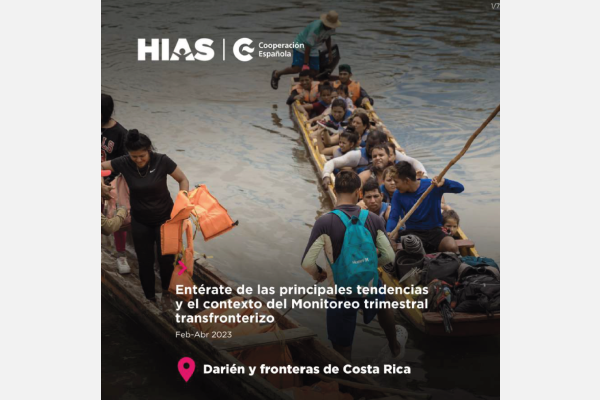Repository of Practices

Cross-border Assistance and Protection for Populations in Transit through the Darién Gap (Colombia and Panama) and the Costa Rican Borders
Dates
Type of practice
Geographic scope
Country:
Regions:
Sub Regions:
Local:
Summary
In recent years, displacement and mobility in South and Central America have massively increased due to severe climate events, insecurity, conflict, and economic collapse. Many people journeying from South America northwards make their way through the Darién Gap, an unforgiving strip of jungle that forms a natural border separating Colombia and Panama, where there are no modern roads or infrastructure. A thick jungle lacking roads and other modern infrastructure, the Darién Gap poses significant environmental risks and the risk of getting lost or going missing. Protection risks in this area abound, and many migrants have reported exposure to robbery, physical violence, threats, extortion, and sexual violence. HIAS operates a cross-border protection and GBV programme supporting migrants along the Darién in Colombia, Panama, and Costa Rica. The initiative began with teams in Neclocí, Colombia, a starting point for migrants entering the Darién Gap from the Colombian side. Teams were also deployed in Gualaca district in Panama, and in Costa Rica teams were available in the Southern and Northern border. HIAS’ protection program seeks to alleviate suffering of migrants and prevent loss of life, through providing protection and GBV services. Legal protection activities emphasise provision of essential information on the context, on protection risks, and on how migrants can access legal asylum and migration pathways. The programme also provides GBV services cross-border, including case management so survivors can access services throughout their journey. GBV activities include provision of dignity kits, safe spaces for women, and access to clinical care following sexual violence. It also offers safe spaces for young children and adolescents. HIAS is additionally conscious of how intersecting identities, such as being LGBTQI+ or living with a disability, may also impact migrants’ vulnerability to violence as well as their ability to access services and information along the migration route. Moreover, HIAS offers mental health and psychosocial support to individuals (psychological first aid and activities organised within safe spaces). HIAS has two curricula, one for use with women and adolescents in transit, and another for women and adolescents remaining in place. Given the programme’s protection focus, HIAS targets those that are most vulnerable to protection violations and GBV, specifically women and adolescent girls in the case of GBV, and children and adolescents. Finally, HIAS also conducts protection monitoring, collecting data on protection risks faced by migrants which is analysed for evidence-based advocacy. The initial financing for the activities was provided internally with HIAS Emergency Funds. Shortly after, AECID was the first donor to fund this project. The activities have since been supplemented by funds from the Hilton Foundation and UNHCR, enabling HIAS to expand the geographic coverage to Honduras.
HIAS takes part in key coordination bodies in each country of operation: in Uruba, Colombia, it takes part in the Interagency Group on Mixed Migration Flows (Grupo Interagencial Sobre Flujos Migratorios Mixtos), within the framework of the R4V platform, as well as with the relevant authorities. In Panama, HIAS participates in various coordination groups, including the gender-based violence (GBV) and protection groups. In Panama and Costa Rica, HIAS has established standard operating procedures.
Organizations
Main Implementing Organization(s)
Detailed Information
Benefit and Impact
Key Lessons
Recommendations(if the practice is to be replicated)
Innovation
During the COVID-19 pandemic, border closures made travel difficult and there were particular challenges with cross-border GBV cases, for example when a GBV survivor needed to cross into another country but was unable due to border closures. During this time, it was also difficult for teams to move easily and offer services to migrants. Consequently, HIAS has adopted some approaches to be done remotely in instances where they do not have physical presence such as in the Caribbean islands. These services include remote vulnerability screenings, and carrying out group and individual MHPSS activities remotely. According to key informants from HIAS, the practice is replicable. Before this project HIAS had the experience of another cross-border project in Colombia, Ecuador, and Peru. This demonstrates that the practice can be replicated in other places adapting guidelines and protocols to other situations and contexts.
Additional Resources
Date submitted:
Disclaimer: The content of this practice reflects the views of the implementers and does not necessarily reflect the views of the United Nations, the United Nations Network on Migration, and its members.
More Related Practices:
- Comité de Cultura de Paz y Derechos Humanos
- Strengthening the capacities and frameworks to collect data and evidence on migration, the environment and climate change (MECC) in Mexico
- Encuesta Nacional Migrante de la Argentina (ENMA)
- A Gender-Focused Qualitative Study on Health Care-Seeking Behavior and Access to Tuberculosis Treatment among Mobile Populations from Moldova
- IOM’s Regional Programme Strengthens the Protection of Child Victims across North Africa and Key Routes
Peer Reviewer Feedback:
*References to Kosovo shall be understood to be in the context of United Nations Security Council resolution 1244 (1999).
Newsletter
Subscribe to our newsletter.